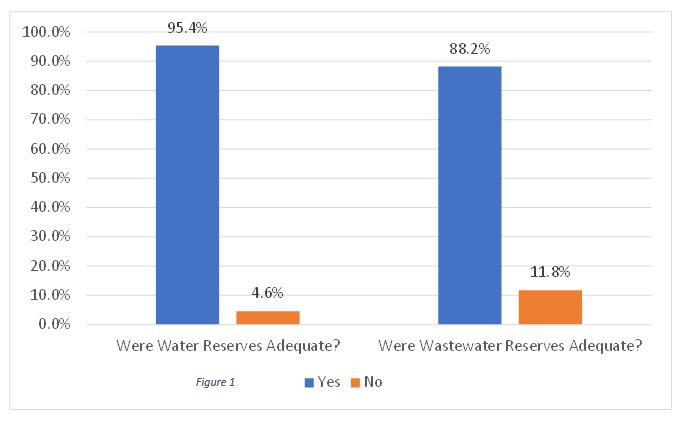The importance of reserve funding for water and wastewater systems has never been so well illustrated as over the past two years. During the COVID-19 pandemic, utilities took extreme measures to ensure that critical clean water and sanitary sewer services were not disrupted, including suspending service shut-off practices. As a result of the disruption to the operation of many businesses, public service offices, and schools, water and wastewater usage characteristics shifted away from non-residential usage to residential usage, creating potential revenue shortfalls for some systems.
The 2022 AE2S Rate Survey asked respondents to comment on how their utilities fared through the pandemic. Participants were asked if sales volumes changed, if revenue changed, and if collection rates changed. The responses to these questions are shown in Table 1. The responses indicated that greater than half of water and wastewater utilities did not experience a significant change in billed volumes or revenue. Approximately 30% of systems experienced increased volumes and revenue, and 10 to 13% of systems experienced a decrease in volume and revenue. In terms of collection, approximately 33% experienced an increase in unpaid bills.

For utilities that experienced decreased sales and/or an increase in past due bills, access to utility fund reserves was critical. Responses to the 2022 Rate Survey indicated that 95% of water systems and 88% of wastewater systems had reserves in place that were adequate to support financial needs through the pandemic (Figure 1). Approximately 11% of respondents noted that utility reserves were tapped, and 3% utilized non-utility reserve funds to account for revenue shortfalls. Approximately 4% of water respondents and 11% of wastewater respondents reported a resulting change in reserve funding approach (Figure 2). Specific modifications noted included:
- Increase rates to fund reserves
- Reconsider capital funding approaches (use of debt)
- Re-prioritization of pipeline renewal projects
- Adjustment of planning projections
- Establishment of a rate stabilization reserve


It is likely that inflationary impacts will continue to pose challenges into 2023. As utilities finalize budgets and fee schedules for 2023, it is important to consider whether rate adjustments are necessary to support a sound reserve funding strategy. Table 2 provides general considerations for setting target balances for utility reserve funds. Figure 3 summarizes Operating Reserve target values provided by respondents to the 2022 AE2S Utility Rate Survey.


